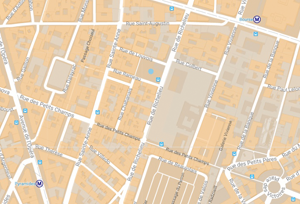Presentation and Guidance of Contributors of the Revue numismatique

PRESENTATION
The Revue numismatique (RN) research interests relate not only to numismatics and monetary history but also to archaeology, economic history, art history, epigraphy, sigillography and glyptic in connection with the study of coins, medals and coin-like objects of all civilisations.
RN publishes original scholarly studies, new material or innovative interpretations of published material. Synthetic papers dealing with specific questions may be accepted.
Articles can be submitted in French, English, German, Italian and Spanish.
Finalised manuscripts complying with the guidance for contributors must be sent to the editor-in-chief by September 1 to be published in the following year’s issue. In a first meeting, each manuscript is submitted to several anonymous reviewers assigned by the editorial committee. At least one of the reviewers has to be a member of the editorial committee. External experts can also be solicited. In a second meeting, reviews are discussed by the editorial committee and papers are selected for publication according to their scientific interest. Publication may be subject to corrections if requested by the editorial committee. The editors inform the authors of the board’s decision by December 31. If an author intends to challenge a decision, he should write to the editor-in-chief who will hand the claim over to the directors. Papers are definitively approved by the management committee. Thereafter, they cannot be published elsewhere.
To be reviewed in RN, books must be sent to the editors with the mention “Revue numismatique”. Book reviews are assigned to experts by the editorial committee. Reviews are both informative and critical. Several books may be dealt with in a single review.
RN reserves the right to refuse any publicity without having to justify its decision.
lkqsdoimhgomjhrfg
Guidance for Contributors
Download Guidance for Contributors
For any questions or clarification, please contact the editors.
Authors must ensure that the material published is legally usable.
As the Revue numismatique is intended to be made available on www.Persee.fr, authors de facto agree that the copyright will belong to the Revue and that they have obtained all necessary permissions to use illustrations from a third party
Submission process
- Articles
Manuscripts of articles must reach the editors by September 1st at the latest for publication in the following year’s issue.
Manuscripts must be original and authors must indicate whether they have submitted their manuscript to another journal.
All manuscripts received are subject to review by the editorial committee of the Revue numismatique, which reports to authors on the publication of the article before December 31. The Revue numismatique is free to ask authors to modify their text or illustrations.
Articles accepted by the editorial committee must reach the editors, in their completed version, at the latest one month after acceptance for publication. Accepted articles may not be published elsewhere.
- Reviews
Reviews must be submitted to the editors by 31 January at the latest for publication in the current year’s issue.
The editorial committee of the Revue numismatique is the only one entitled to choose the authors of the reviews of the works received.
Presentation of manuscripts
CAUTION: Failure to comply with the following formal rules may justify rejection of the article by the editorial committee.
The Revue is aimed at an international audience and accepts articles written in French, German, English, Spanish and Italian.
Reviews should not exceed 10,000 characters including spaces. Footnotes and figures are not allowed
Articles should not exceed 100,000 characters including spaces, notes and figures.
The manuscript submitted for review must be written concisely (ensure consistency of presentation, particularly in the use of capitals and punctuation). It must be complete and include in all cases
- the name of the author (First name LAST NAME) with a note on his/her e-mail address and possibly his/her institutional affiliation;
- an abstract (600 characters maximum, including spaces) in French and English;
- five French and English keywords.
- figures in the text to display the layout, and in separate files (see below).
Manuscripts are submitted as Word (.doc or .docx) and PDF files.
Tabs, indents, page breaks, style tags and personal formatting are not allowed.
For non-Latin characters, the use of Times Unicode is recommended. For oriental languages, a pdf file and the original font must be provided. For Greco-Roman special characters, use the Unicode font Athena Ruby (downloadable from https://www.doaks.org/resources/athena-ruby).
Illustrations (images, tables, maps and graphs)
CAUTION: Authors must ensure that all illustrations do not exceed a maximum size of 12 x 18.5 cm (including legend), in order to fit the format of the publication.
All illustrations (image, graph, map or table) are called “figures”
They are numbered consecutively and given a caption which appears in the body of the text in the desired position. Figures and plates should be referred to in the text as “(figure/plate x)”.
Illustrations may be provided in colour. Offprints sent to the authors will be produced in colour, the Revue numismatique remaining in black and white.
Illustrations’ files are entitledg as followed: NAME(S)-NUMBER (e.g.: OLIVIER-DROST-01).
- Photographs
Specify whether they are to be inserted in the text or grouped in plates. The author may provide a plate mounted as a model, but must also provide all the illustrations as separate files: the plate will be reassembled according to the model, within the limits of the general layout constraints of the article and the Revue (12 x 18.5 cm caption included).
Specify if they are to be enlarged, no more than threefold (3:1)
It is imperative to provide the original image files in TIFF format (or JPEG with maximum quality) with a resolution of at least 300 dpi and proportional to the desired size (300 dpi for 1:1 scale, 450 dpi for 1.5:1 scale, 600 dpi for 2:1 scale, etc.), if possible on a white background, supplying in the name of the file the dimensions in mm at 1:1 scale (e.g. OLIVIER-DROST-01-Obverse/Reverse-31mm).
Authors are asked not to crop the images of coins.
In the final publication, any lower resolution will result in a proportional reduction or deletion of the illustration.
- Maps
Provide a vectorised (editable) version in Adobe Illustrator (or equivalent software) or .pdf format.
- Tables
Are inserted directly into the body of the text, using the table function in Word and not an Excel spreadsheet.
Authors must ensure that the layout template is strictly adhered to, and that the font size is no smaller than 8 pts.
- Graphs
Should not be provided as image files but with the spreadsheet file (Excel or any other equivalent software), one file per chart. A PDF version should also be provided.
Measurements, dates and first names
Use standard abbreviations: mm, g (with no full stop)…
Use the forms 1., s. and d. for pound, penny and denarius: 108 1. 13 s. 6 d.
The Revue does not abbreviate “century” and century references should be in figures if it’s a noun (7th century) and spelled out if it is an adjective (seventh-century coins).
References
Cross-references are indicated as p. 000 and will be changed when the proofs are delivered.
Bibliographical references are presented in accordance with “scientific” usage (‘Harvard’ system).
References appear in footnotes or in brackets within the text as follows: author’s name in small capitals, year, pagination.
BARRANDON 1988a, pp. 7-8, 13.
The bibliography at the end of the article indicates the author’s name in small capitals, the initial of the first name, the title of the article (without inverted commas), the title of the book or journal in italics, the title for journals, possibly the collection for books, the place of publication, the date, the pagination for articles only.
Note: Small capitals are easily obtainedon PCs, once you selected the name, with the shortcut CTRL+Shift+K. The corresponding shortcut on Macs is Command+Shift+K.
Examples:
BARRANDON 1988: J.-N. BARRANDON, Le volume du flan, RN, 30, 1988, p. 7- 15.
GRANDJEAN 2021: C. GRANDJEAN (ed.), The Koina of Southern Greece. Historical and Numismatic Studies in Ancient Greek Federalism, Numismatica Antiqua, 12, Bordeaux, 2021.
PICARD 2005: O. PICARD, L’apport des monnaies des fouilles d’Alexandrie, in L’exception égyptienne ? Production et échanges monétaires en Égypte hellénistique et romaine. Actes du colloque d’Alexandrie, 13-15 avril 2002, Fr. DUYRAT, O. PICARD (eds.), Études alexandrines, 10, Cairo, 2005, pp. 465-493.
For more than two authors, please use the mention et al.:
MORRISSON et al. 1982: C. MORRISSON, J.-N. BARRANDON, Cl. BRENOT, J.-P. CALLU, R. HALLEUX, J. POIRIER, Numismatique et histoire. L’or monnayé de Rome à Byzance : purification et altération, CRAI, 126-2, 1982, p. 203-223.
Sale catalogues are cited as follows: name of the auction house if possible abbreviated, sale number, date of sale, lot number:
CNG 278, 25/04/2012, lot 502.
Proofs
Authors receive a set of proofs to be corrected, which they must return to the editors within three weeks. After this period, only corrections made by the editorial committee will be taken into account, without the editors being held responsible.
Abbreviations
The abbreviations of titles and institutions of the Année Philologique must be used in the bibliographies of articles and in the citations of reviews. The most commonly encountered in the Revue are listed below. See also https://guides.lib.berkeley.edu/c.php?g=381579&p=2585381



